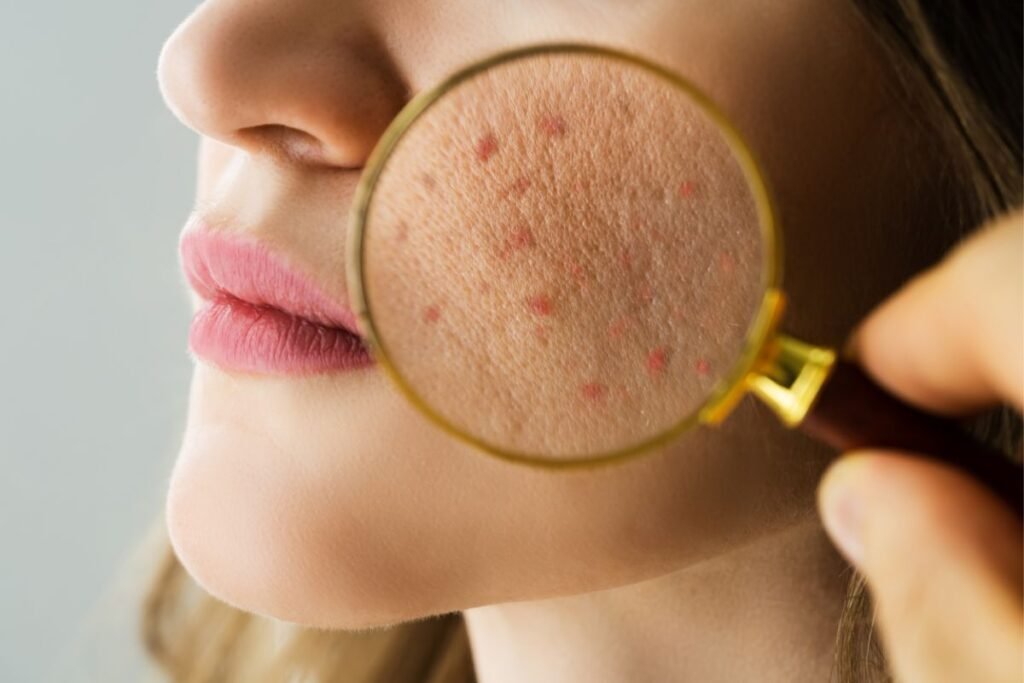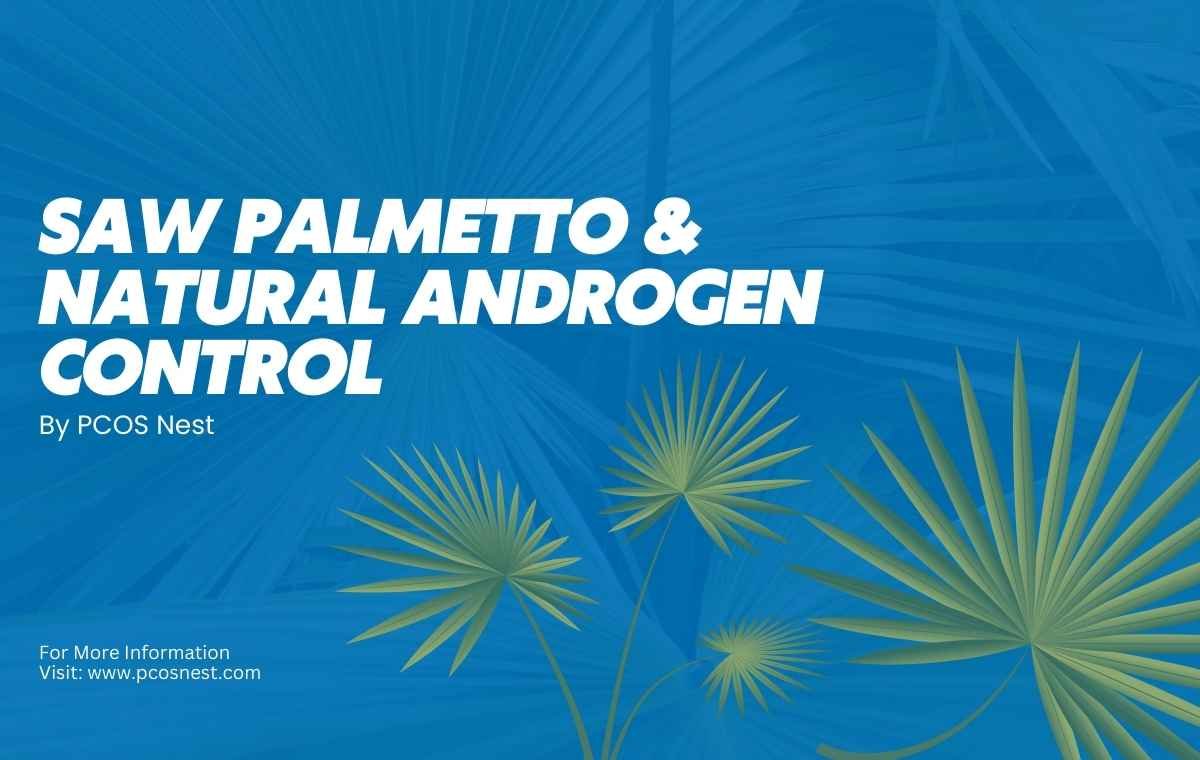If your breakouts flare around your period, or your hairline seems to thin while body hair gets thicker, androgens (a group of hormones that includes testosterone and its potent cousin DHT) may be involved. This guide explains how androgens drive acne and hair loss, what the science says about saw palmetto as a natural option, and how to build a smart, step-by-step plan that prioritizes safety and proven treatments—then adds supplements the right way.

1) Androgens 101: Why They Matter for Skin and Hair:
Sebum and pores. In acne, androgens increase the size and activity of oil glands. More oil plus sticky dead skin cells can clog pores, leading to whiteheads, blackheads, and inflamed bumps. This is one reason acne is common in the teen years and can persist or return in adulthood when hormones fluctuate.
DHT and the hair follicle. In androgenetic alopecia (pattern hair loss), hair follicles on the scalp are sensitive to dihydrotestosterone (DHT). DHT slowly shrinks follicles, making hairs thinner and shorter over time. Medical treatments that reduce DHT, such as finasteride (oral) and dutasteride, can slow this process—illustrating how central the androgen pathway is for hair.
2) Where Does Saw Palmetto Fit?
What it is. Saw palmetto (Serenoa repens) is a berry extract used most often for prostate symptoms. It’s also marketed for hair loss and sometimes for “hormonal” acne. Modern lab and review articles suggest it may inhibit 5-alpha-reductase, the enzyme that turns testosterone into DHT, and may also reduce DHT’s ability to bind its receptor. Think of it as a mild, plant-derived anti-androgen signal blocker.
How strong is the evidence?
- Hair: Small randomized trials and cohort studies (often using 100–320 mg/day or topical formulas) report modest improvements in hair quality and density for some people with pattern hair loss or telogen effluvium. Results vary, methods differ, and studies are small, but there is a signal of benefit.
- Acne: There are no large, high-quality trials showing that saw palmetto clears acne. Most evidence for acne focuses on prescription anti-androgens (like spironolactone) or topical androgen blockers (like clascoterone). So, if acne is your main concern, saw palmetto should be considered experimental and optional—not a first-line treatment.
Safety snapshot. Major U.S. health agencies say saw palmetto appears well-tolerated for most adults, with mild stomach upset as the most common side effect. However, high-quality safety data in women and teens are limited, and it should be avoided during pregnancy or breastfeeding. Supplements can vary in strength and purity.
3) Acne Strategies That Target Androgens (and That Work):
A. Start with proven basics (daily routine):
- Gentle cleanse twice daily; avoid harsh scrubs.
- Topical retinoid at night (adapalene, tretinoin, tazarotene) unclogs pores and calms inflammation.
- Benzoyl peroxide in the morning (or with topical antibiotics if prescribed) reduces acne bacteria and helps prevent resistance.
These are core steps recommended in dermatology guidelines.
B. Add targeted anti-androgen therapy if needed:
- Oral spironolactone (women and some gender-diverse patients): Blocks the androgen receptor and reduces oil. Newer and updated guidelines conditionally recommend it for female acne based on moderate-certainty evidence; several trials and large real-world studies support meaningful improvement. It is not used in pregnancy and typically requires contraception. Work with your clinician to choose a dose (commonly 50–100 mg/day to start).
- Topical clascoterone 1% cream (all genders ≥12 years): A prescription cream that blocks the androgen receptor locally in the skin. Two phase-3 trials (over 1,400 patients) showed better clearance than vehicle with a low rate of side effects, making it a solid option if you want an androgen-targeting topical without systemic effects.
C. Diet and lifestyle that ease the androgen “push”:
- Low-glycemic eating and keeping insulin spikes in check can help some people, since insulin-like growth factor-1 (IGF-1) interacts with androgens in acne biology.
- Stress management (sleep, exercise, relaxation) may help reduce stress-related flares.
These steps complement medical treatment even though they’re not stand-alone cures. (See hormone–acne discussions and reviews.)
D. Where saw palmetto might fit for acne:
If you and your clinician want to try a natural adjunct, a standardized liposterolic extract of S. repens could be tested for 8–12 weeks alongside the guideline-based plan above—with the understanding that evidence for acne is limited. Choose a product that discloses dose and extraction method; research often uses 100–320 mg/day of standardized extract. Stop and reassess if you notice side effects or no benefit.
Also Read: What Causes Hirsutism in Females?
4) Hair Strategies That Address Androgens (With or Without Saw Palmetto):
A. Foundation treatments with the strongest evidence:
- Topical minoxidil (2%–5%): Extends the growth phase of hair. Safe for most, first-line for men and women.
- 5-alpha-reductase inhibitors (medical):
- Finasteride (type II inhibitor) for men and some post-menopausal women.
- Dutasteride (type I and II) in select cases under specialist care.
These lower scalp DHT and can slow or partially reverse androgenetic alopecia. Discuss risks, monitoring, and pregnancy considerations with your clinician.
B. Saw palmetto as a possible add-on for hair:
Small trials and case series suggest that oral (100–320 mg/day) or topical saw palmetto may improve hair quality or density in some people. Effects are generally milder than prescription 5-AR inhibitors, and study sizes are small. If you prefer a natural approach or cannot use finasteride/dutasteride, it may be reasonable to trial a quality standardized extract for 3–6 months while keeping expectations realistic.
C. Practical hair routine:
- Stick with minoxidil twice daily (foam or solution).
- Consider microneedling (under guidance) to boost response to minoxidil.
- Add saw palmetto only as an adjunct, not a replacement for proven therapy.
- Track progress with monthly photos in the same light and hairstyle.
5) Safety, Quality, and Smart Use of Supplements:
- Not for pregnancy or breastfeeding. Because of possible hormonal effects and limited safety data, avoid saw palmetto during pregnancy or while nursing.
- Side effects are usually mild (stomach upset), but stop if you notice unusual bleeding, rash, or severe symptoms. Evidence of interactions is limited, yet always review your full medication list with your clinician.
- Choose standardized extracts. Look for “lipidosterolic” or “supercritical CO₂” extracts with stated fatty acid content; potency can vary a lot between brands, which may explain mixed study results.
- Supplements don’t replace prescriptions when those are needed. For moderate–severe acne or fast hair loss, start guideline-backed therapy first, then layer in supplements if desired. (PubMed)
6) A Simple, Evidence-Aware Game Plan:
If acne is your main issue:
- Core routine: topical retinoid nightly + benzoyl peroxide in the morning.
- Escalate if needed:
- Women: consider spironolactone (with birth control if pregnancy is possible).
- All genders ≥12: consider clascoterone 1% cream as an add-on.
- Lifestyle: low-glycemic meals, regular sleep, stress reduction.
- Optional adjunct: trial saw palmetto (standardized 100–320 mg/day) for 8–12 weeks only if you want a natural add-on—recognizing evidence for acne is limited. Reassess with your clinician.

If hair shedding/thinning is your main issue:
- Start minoxidil and stick with it.
- Discuss DHT-lowering options (finasteride/dutasteride where appropriate).
- Optional adjunct: add saw palmetto (oral or topical) for 3–6 months while monitoring hair density and shedding. Manage expectations; benefits, if any, are usually modest.
7) Key Takeaways:
- Androgens drive both acne (via oil glands) and pattern hair loss (via DHT on follicles). Blocking these signals can help.
- Saw palmetto likely lowers DHT activity in lab and small clinical studies. It is promising for hair as an adjunct, but evidence for acne is limited. Quality and dose matter.
- Best-supported options for acne: topical retinoids, benzoyl peroxide, and—when indicated—spironolactone (women) or clascoterone cream for local anti-androgen action.
- Safety first: avoid saw palmetto in pregnancy/breastfeeding; discuss all meds and supplements with your clinician.
References (selected):
- American Academy of Dermatology (AAD). Why does acne develop? and related pages on acne pathogenesis and care.
- AAD Clinical Guideline Update (2024). Guidelines of care for the management of acne vulgaris (evidence-based recommendations; conditional recommendation for spironolactone).
- NCCIH (NIH). Saw Palmetto: Usefulness and Safety and Spotlight on Saw Palmetto: What the Science Says (safety overview; limited evidence outside prostate use; caution in pregnancy).
- Dermatology and pharmacology reviews on DHT and 5-alpha-reductase in hair loss (finasteride/dutasteride mechanisms).
- Systematic reviews on saw palmetto for hair. Small trials report modest benefits with oral/topical doses around 100–320 mg/day but with heterogeneous methods.
- Clascoterone (Winlevi) evidence base. Two phase-3 RCTs showed superiority over vehicle with a favorable safety profile; FDA approval summary and medical reviews.
- Hormone–acne links in women. Reviews describing androgen excess, IGF-1, and adult female acne patterns.
Final note:
Use doctor-led treatments first for predictable results, then layer saw palmetto as a cautious experiment if you prefer natural support—especially for hair. Track your skin and scalp monthly, and review progress with your healthcare professional so you can keep what helps and stop what doesn’t.

